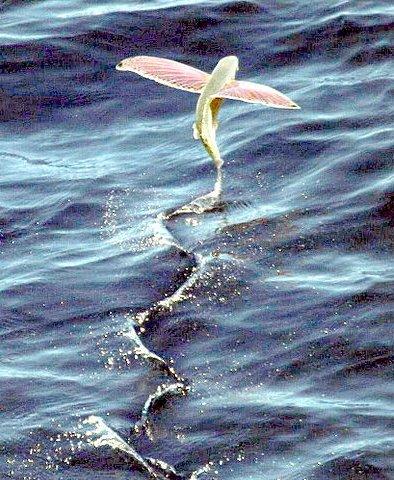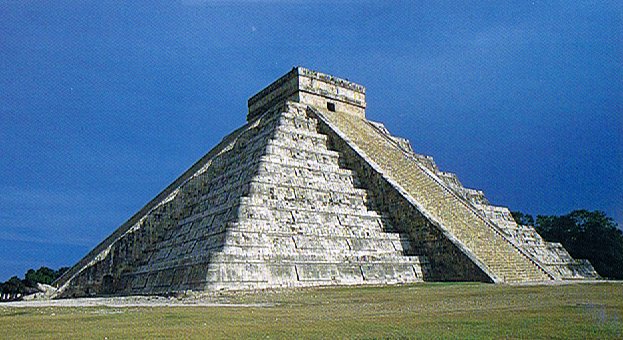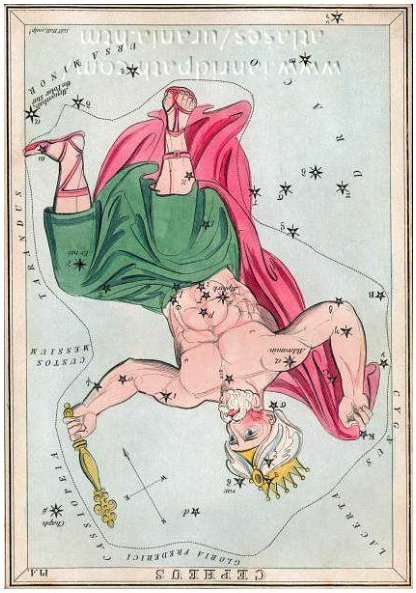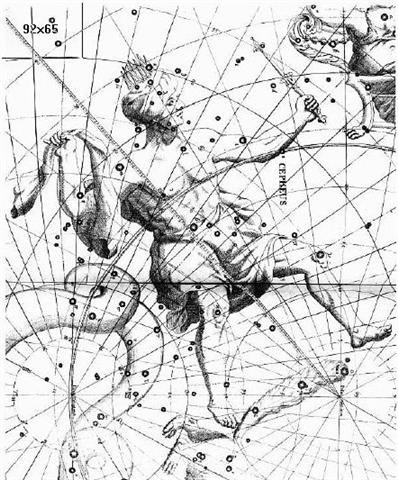7. The 13th and 14th sons of Tu were Moko and Maroro, and I have implicated that this pair of characters could correspond to 2 * 20 = 40 days when Sun is down in the Underworld, the tau moko season.
Maroro was also the name of the flying fish, which could be connected to the Flying Serpent - equally strange creatures:
In my basic astronomy book the picture of Lacerta is like an undulating river of stars, like the zigzag sign of Kukulkan (or of the kava glyph type):
The head of this 'Flying Fish' could correspond to δ Cephei (Alrediph, Al Radif) and its tail to β Persei, so much seems hinted at, and Allen has information which supports it, e.g.: "Surrounding δ, ε, ζ, and λ, which mark the King's head, is a vacant space within the southern edge of the Milky Way similar to the Coal-sacks of the Northern and Southern Cross." King Cepheus is upside down like his Queen, and they both have passed away:
This spectre of a King is still holding on to his sceptre (which however, we can assume, already has dropped down to become 'Frederick's Glory'), and it is close to the back side of his Queen according to Flamsteed:
Although time evidently runs according to right ascension the explanation of the pictures could run also from high on and downwards, and we therefore need to contemplate all the surrounding constellations to understand the fundamental story. Wikipedia: "The term cepheid originates from Delta Cephei in the constellation Cepheus, the first star of this type identified, by John Goodricke in 1784 ... Classical Cepheids (also known as Population I Cepheids, Type I Cepheids, or Delta Cephei variables) undergo pulsations with very regular periods on the order of days to months ..." Surely the ancients must have noticed this phenomenon much earlier than John Goodricke. An idea of rain temporarily occluding a star could have generated the consequent idea of a 'spout' then delivering this rain water downwards through e.g. Lacerta. In parallel with studying the stars we also have to remember to integrate at their proper places all the myths and great old stories which we know contain clues as to how to 'read' the sky. The 'coal-sack' close to the Old King seems to be ready to collect his head (like a still superhot coal), this we can deduce from various descriptions - not immediately understood as relevant - such as in the rope-trick: ... the rope would seem to rise high into the skies, disappearing from view. The boy would climb the rope and be lost to view. The magician would call back his boy assistant, and, on getting no response, become furious. The magician then armed himself with a knife or sword and climbed the rope, vanishing too. An argument would be heard, and then limbs would start falling, presumably cut from the assistant by the magician. When all the parts of the body, including the torso, landed on the ground, the magician would climb down the rope. He would collect the limbs and put them in a basket, or collect the limbs in one place and cover them with a cape or blanket. Soon the boy would appear, restored ... I suggest the 'rope' impossibly rising high of itself into the skies is visualizing Lacerta (first like a tall flame rising upwards and later like a river of cut off bodyparts dropping down). Line Gb3 (with no henua but with hanau) could refer to the 'coal-sack' (similar to an uterus) close to the famous variable Cepheid star δ. 22h is equal to (22 * 60) / 1440 * 365.25 =334.8 and 23h to 350.3, which means Alrediph should be around day number 342. If we reduce by 64 the result is 278 and this points at Gb2-22 (26 glyphs before moko in Gb3-13):
Aquarius is a long constellation and it stretches all the way below the Square of Pegasus including Scheat (β) at the bottom end of the 'Lizard' (which also is where the left hand of Andromeda has been depicted as fettered to a 'rock'). Scheat is at right ascension 23h 01m which translates to day number 350.3 and after a reduction with 64 we should search for this star around glyph number 286 (where 2-30 can allude to glyph number 230):
In Allen we can first of all find that also the 'tail' star of the Stellion is variable: "The variability of β was discovered by Schmidt in 1847, and Argelander found a period of forty-one days ..." But of greater interest for our quest is how it is possible (at least tentatively) to form an idea of the 'rock' of the Pegasus Square as both a couch and as a stand or platform for the dead (maybe even as a litter carried by 4 sons):
... The younger, but true son, Horus, on the other hand, had been more fortunately conceived - according to some, when Isis lay upon her dead brother in the boat, or, according to others, as she fluttered about the palace pillar in the form of a bird ...
Counting days from Sirrah (1.5) - 'the woman in chains' (probably because this star is both α Andromedae and a corner of the Pegasus Square) - to Scheat (350.3) could point at Gb2-28 because 350.3 - 1.5 = 348.8 and after reducing by 64 the result is 284.4:
I find the appearance of a vaha mea glyph here significant. (28 * 4 = 8 fortnights and 22 * 8 - 14 * 8 = 8 * 8 = 64.) But it is all very complicated and we had better end here by reading on some more in Allen: "This is the Scheat of Tycho, the Palermo Catalogue, and modern lists generally, either from Al Sā'id, the Upper Part of the Arm, or, as Hyde suggested, from the early Sa'd, appearing in the subsequent three pairs of stars. Bayer had Seat Alpheras; Chilmead, Seat Alfaras; Riccioli, Scheat Alpheraz; and Schickard, Saidol-pharazi. Arabian astronomers knew it as Mankib al Faras, the Horse's Shoulder, mentioned by Ulug Beg and still occasionally seen as Menkib. Chilmead had Almenkeb. The Great Square, of which β formed one corner, constituted the double asterism, the 24th and 25th 'nakshatras', Pūrva, Former, and Uttara, Latter, Bhādra-padā, Beautiful, Auspicious, or Happy Feet, sometimes also called Proshtha-padā, 'Proshta' meaning a Carp or Ox; but Professor Whitney translated it 'Footstool Feet', and said that the authorities do not agree as to the figures by which they were represented, for by some the one, by others the other, is called a Couch or Bed, the alternate one, in either case, being pronounced a Bifaced Figure, or Twins. The Couch is a not inapt representation of the group if both asterisms are taken together, the four stars well marking the feet. Weber calls them Pratishthana, a Stand or Support, as Whitney wrote, an evident allusion to the disposition of the four bright stars which compose it, like the four feet of a stand, table, bedstead, or the like; the regents of these 'nakshatras' being Aja Ekapāt, the One-footed Goat, and Ahi Budhya, the Bottom Snake, 'two mythical figures, of obscure significance, from the Vedic Patheon'. The 24th 'manzil', formed by α and β, was Al Fargh al Mukdim, the Fore Spout, i.e. of the water-bucket, - Al Birūni's Al Fargh al Awwal, the First, or the Upper, Spout ..." I cannot resist reminding the reader of the Serpent's Couch: ... Snorri Sterluson explains why 'Frodi's grist' is a kenning for gold. Frodi ruled during a peaceful and productive period, contemporaneous with Augustus's Pax Romana and the birth of Christ; hence the kenning. There were neither thieves nor robbers during this period, 'so that a gold ring lay long on Jalang's heath'. Snorri continues his account with the legend of the mill beyond what is told in the song: The girls' grinding produced an army hostile to Frodi. On the very day of the girls' predictions, the sea-king, Musing (Son of the Mouse), landed on the Danish shore, killed Frodi, and took away Grotti and the women on his ship. The girls were bidden to grind out salt on the mill. At midnight they asked for further instructions. 'Keep grinding', he told them. Then they ground with such vigor that the ship sank. Water poured into the eye of the mill, creating the maelstroem of the sea. Therefore the sea was salt. Incidentally, the mill was given a kenning, Serpent's Couch ... 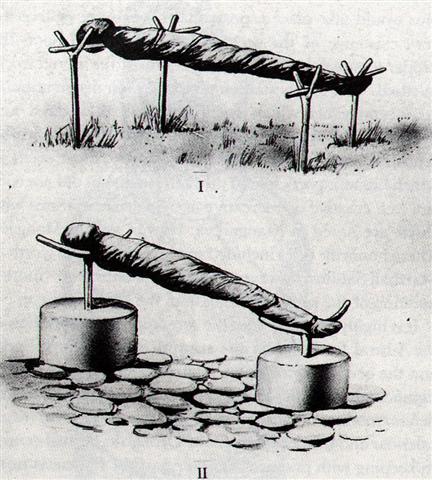 (Examples of toga, the wooden platforms for dead chiefs, cfr in Kava.) |



